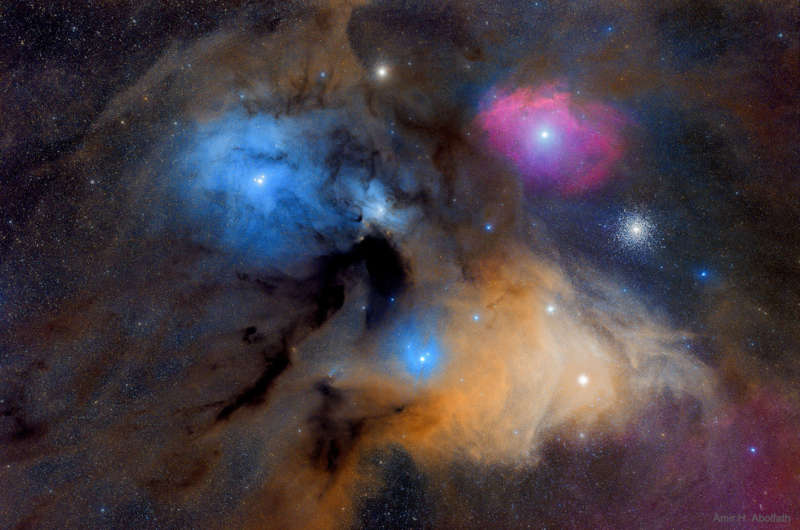Credit & Copyright: Amir H. Abolfath
Explanation:
The many spectacular colors of the
Rho Ophiuchi
(oh'-fee-yu-kee) clouds highlight the many processes that occur there.
The blue regions shine primarily by reflected light.
Blue light from the
Rho Ophiuchi star system
and nearby stars reflects
more efficiently off this portion of the nebula than red light.
The Earth's
daytime sky appears blue for the same reason.
The red and yellow regions shine primarily because of
emission from
the nebula's atomic and molecular gas.
Light from nearby blue stars - more energetic than the bright star
Antares - knocks
electrons
away from the gas, which then shines when the electrons
recombine with the gas.
The dark brown regions are caused by
dust grains - born in young stellar atmospheres -
which effectively block light emitted behind them.
The Rho Ophiuchi star clouds,
well in front of the
globular
cluster
M4 visible
here
on the upper right, are even more colorful than
humans can see - the clouds emits light in every
wavelength band from the
radio
to the
gamma-ray.
Astrophysicists:
Browse 2,200+ codes in the Astrophysics Source Code Library
1999 2000 2001 2002 2003 2004 2005 2006 2007 2008 2009 2010 2011 2012 2013 2014 2015 2016 2017 2018 2019 2020 2021 2022 2023 2024 2025 |
Январь Февраль Март Апрель Май Июнь Июль Август Сентябрь Октябрь Ноябрь Декабрь |
NASA Web Site Statements, Warnings, and Disclaimers
NASA Official: Jay Norris. Specific rights apply.
A service of: LHEA at NASA / GSFC
& Michigan Tech. U.
|
Публикации с ключевыми словами:
Rho Ophiuchi - Змееносец - отражательные туманности - эмиссионная туманность
Публикации со словами: Rho Ophiuchi - Змееносец - отражательные туманности - эмиссионная туманность | |
См. также:
Все публикации на ту же тему >> | |
